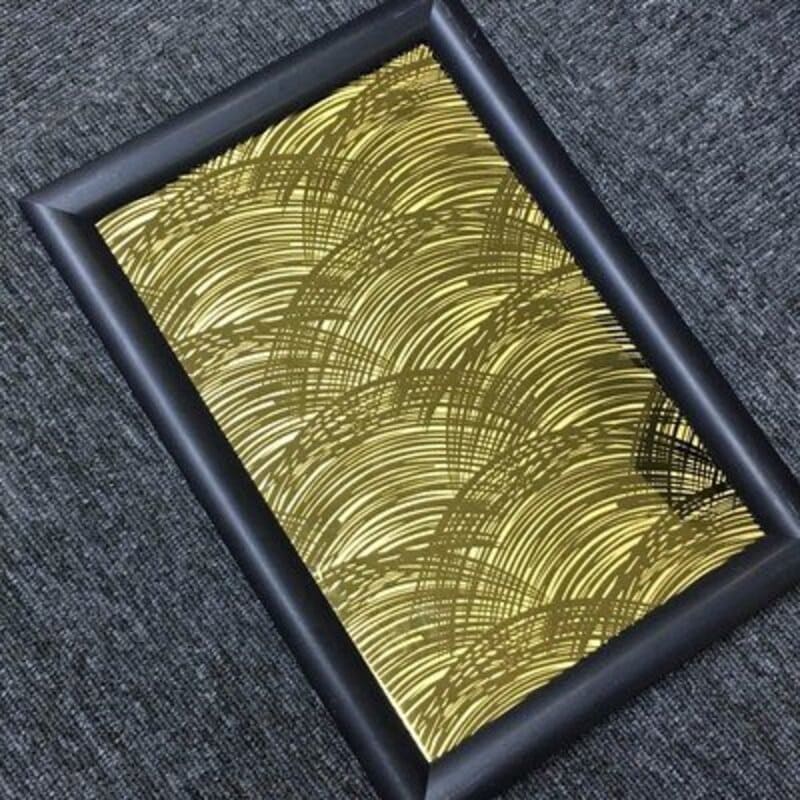
At present, stainless steel corrosion in the industry is mainly divided into chemical corrosion and electrolytic corrosion. Large-scale chemical corrosion is dominant and faster. Whether it is chemical corrosion or electrolytic corrosion, the principle is very simple, that is, cover the areas that do not need to be corroded, and expose the areas that need to be corroded. Different patterns can be corroded using different templates.
The main process of stainless steel corrosion:
1. Pre-treatment (degreasing, polishing, wire drawing, etc)2. Plate making (expose the places that need to be corroded, and protect the ones that don't need corrosion)
3.Etching (chemical etching or electrolytic etching)
4.Remove the version (remove the protective film of the non-corroded area)
5.Late stage (varnish protection, protective film, etc)
The scientific process of stainless steel corrosion
(1) Stainless steel corrosion-drawing design and film productionUse higher-end computer-aided design technology to design the metal parts that need to be produced, and the software mainly uses CAD/CAM software. After the drawing design is completed, the mask film is formed by exposure to special equipment. In the design process, it is necessary to design according to the dimensions of the drawings and related technical requirements, and accurately design the edges of the parts and the cutting and breaking lines for the process according to the accuracy of the etching process (produced during the production process, and removed after the finished product). At the same time, the number of parts on each film is determined by combining the blanking specifications of the main materials to achieve the maximum material utilization rate.
(2) Stainless steel corrosion-blanking cleaning
Determine the size and specifications of the blanking material according to the design. Nowadays, a large number of metals such as imported iron-nickel alloy and imported copper strip are used. The blanking material must not have burrs, scratches and deformation. The four sides of the material are at right angles to each other, and the angle error and the variable length error are within ±0.3mm. After the material is cut, the oil is removed and cleaned, and the surface needs to be free of dirt, stains and scratches after drying.
Through at least 250 mesh screen printing, 1500# and 1501# special inks are used in combination with the thinner. The ink thickness is as uniform as possible. Set the drying temperature according to the characteristics of the part itself for effective drying.
Exposure is done in a clean room, and generally needs to reach class 100,000. According to different materials and inks, different exposure times and exposure levels can be set correspondingly. The exposure machine must be turned on half an hour in advance and the exposure level must be tested, and then the exposure procedure can be carried out when the requirements are met. According to the different configuration of materials and ink, the corresponding developing solution is developed by the developing machine, pumped and dried by hot air. Pay special attention to the need to revise the layout at the end, remove excess film, etc. to ensure the pass rate of the finished product.
This step is an important step. First, prepare the etching solution, and now mainly use ferric chloride solution. Configure different concentrations according to the characteristics of the parts to achieve better results. The main influencing factors are solution temperature, concentration, and etching speed. After etching, the mold is removed by caustic soda solution, and finally cleaned and dried.

Hongwang Group is an enterprise specializing in the production of stainless steel cold-rolled coils and stainless steel surface finishing products, with a wide range of products and complete models. We look forward to your contact.
New trend of anti-rust packaging of new energy drive motor core
2024-07-29Silicon steel coating process introduction (2)
2023-03-14Application of silicon steel in the field of new energy vehicles
2022-09-26Electrical steel production capacity is growing rapidly, and supply and demand are unbalanced
2023-12-05Magnetic Flux Density Optimization in Transformer Core Design
2024-11-25Production technology of cold rolled non-oriented electrical steel
2023-09-08






